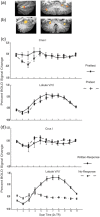Evidence for Cerebellar Contributions to Adaptive Plasticity in Speech Perception
- PMID: 24451660
- PMCID: PMC4481605
- DOI: 10.1093/cercor/bht428
Evidence for Cerebellar Contributions to Adaptive Plasticity in Speech Perception
Abstract
Human speech perception rapidly adapts to maintain comprehension under adverse listening conditions. For example, with exposure listeners can adapt to heavily accented speech produced by a non-native speaker. Outside the domain of speech perception, adaptive changes in sensory and motor processing have been attributed to cerebellar functions. The present functional magnetic resonance imaging study investigates whether adaptation in speech perception also involves the cerebellum. Acoustic stimuli were distorted using a vocoding plus spectral-shift manipulation and presented in a word recognition task. Regions in the cerebellum that showed differences before versus after adaptation were identified, and the relationship between activity during adaptation and subsequent behavioral improvements was examined. These analyses implicated the right Crus I region of the cerebellum in adaptive changes in speech perception. A functional correlation analysis with the right Crus I as a seed region probed for cerebral cortical regions with covarying hemodynamic responses during the adaptation period. The results provided evidence of a functional network between the cerebellum and language-related regions in the temporal and parietal lobes of the cerebral cortex. Consistent with known cerebellar contributions to sensorimotor adaptation, cerebro-cerebellar interactions may support supervised learning mechanisms that rely on sensory prediction error signals in speech perception.
Keywords: adaptation; cerebellum; fMRI; perceptual learning; supervised learning.
© The Author 2014. Published by Oxford University Press. All rights reserved. For Permissions, please e-mail: journals.permissions@oup.com.
Figures







Similar articles
-
On-line plasticity in spoken sentence comprehension: Adapting to time-compressed speech.Neuroimage. 2010 Jan 1;49(1):1124-32. doi: 10.1016/j.neuroimage.2009.07.032. Epub 2009 Jul 24. Neuroimage. 2010. PMID: 19632341 Free PMC article.
-
Sensory-motor brain network connectivity for speech comprehension.Hum Brain Mapp. 2010 Apr;31(4):567-80. doi: 10.1002/hbm.20888. Hum Brain Mapp. 2010. PMID: 19780042 Free PMC article.
-
Sublexical properties of spoken words modulate activity in Broca's area but not superior temporal cortex: implications for models of speech recognition.J Cogn Neurosci. 2011 Oct;23(10):2665-74. doi: 10.1162/jocn.2011.21620. Epub 2011 Jan 24. J Cogn Neurosci. 2011. PMID: 21261450 Free PMC article.
-
Contributions of cerebellar event-based temporal processing and preparatory function to speech perception.Brain Lang. 2016 Oct;161:28-32. doi: 10.1016/j.bandl.2015.08.005. Epub 2015 Sep 9. Brain Lang. 2016. PMID: 26362972 Review.
-
Re-examining selective adaptation: Fatiguing feature detectors, or distributional learning?Psychon Bull Rev. 2016 Jun;23(3):678-91. doi: 10.3758/s13423-015-0943-z. Psychon Bull Rev. 2016. PMID: 26438255 Free PMC article. Review.
Cited by
-
Cerebellar contributions to motor control and language comprehension: searching for common computational principles.Ann N Y Acad Sci. 2016 Apr;1369(1):154-71. doi: 10.1111/nyas.13094. Ann N Y Acad Sci. 2016. PMID: 27206249 Free PMC article. Review.
-
Speech motor brain regions are differentially recruited during perception of native and foreign-accented phonemes for first and second language listeners.Front Neurosci. 2014 Sep 3;8:275. doi: 10.3389/fnins.2014.00275. eCollection 2014. Front Neurosci. 2014. PMID: 25232302 Free PMC article.
-
An fMRI study investigating effects of conceptually related sentences on the perception of degraded speech.Cortex. 2016 Jun;79:57-74. doi: 10.1016/j.cortex.2016.03.014. Epub 2016 Mar 25. Cortex. 2016. PMID: 27100909 Free PMC article.
-
Dimension-based statistical learning of vowels.J Exp Psychol Hum Percept Perform. 2015 Dec;41(6):1783-98. doi: 10.1037/xhp0000092. Epub 2015 Aug 17. J Exp Psychol Hum Percept Perform. 2015. PMID: 26280268 Free PMC article.
-
Predictive processing increases intelligibility of acoustically distorted speech: Behavioral and neural correlates.Brain Behav. 2017 Aug 4;7(9):e00789. doi: 10.1002/brb3.789. eCollection 2017 Sep. Brain Behav. 2017. PMID: 28948083 Free PMC article.
References
-
- Ackermann H, Graber S, Hertrich I, Daum I. 1997. Categorical speech perception in cerebellar disorders. Brain Lang. 60:323–331. - PubMed
-
- Albus J. 1971. A theory of cerebellar function. Math Biosci. 10:25–61.
-
- Altmann GTM, Young D. 1993. Factors affecting adaptation to time-compressed speech Paper Presented at the EUROSPEECH ‘93, Berlin, Germany.
-
- Baizer JS, Kralj-Hans I, Glickstein M. 1999. Cerebellar lesions and prism adaptation in macaque monkeys. J Neurophysiol. 81:1960–1965. - PubMed
Publication types
MeSH terms
Substances
Grants and funding
LinkOut - more resources
Full Text Sources
Other Literature Sources
Medical

